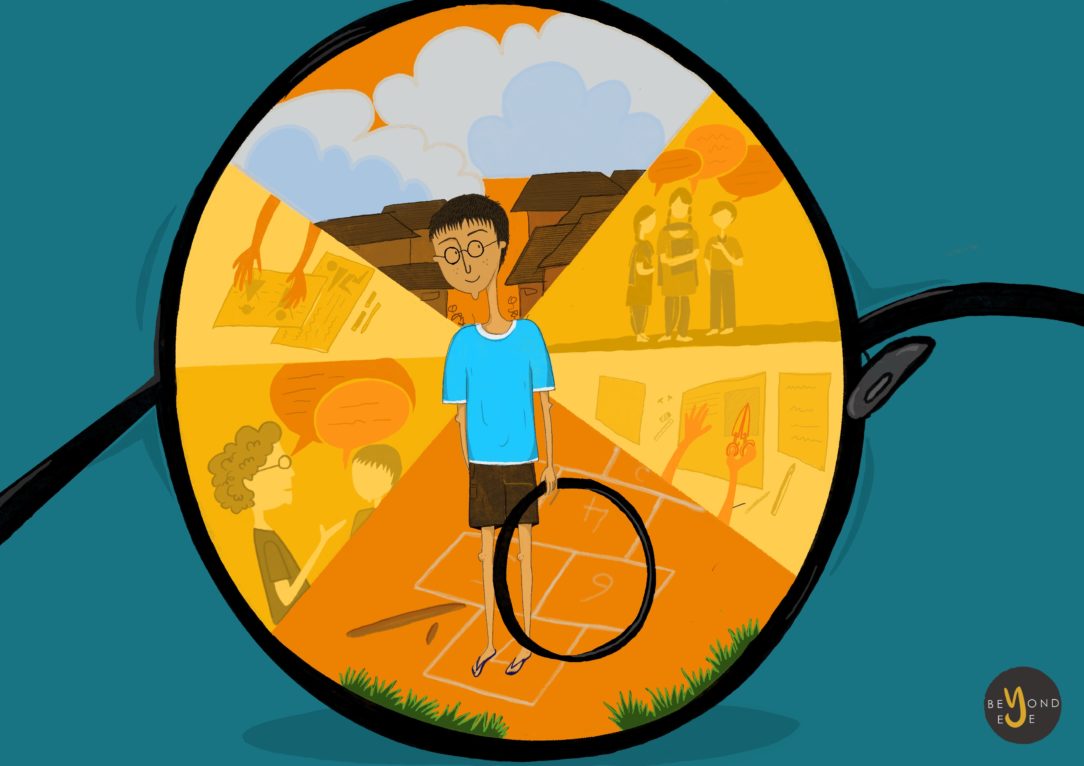
“Kya mein apka chashma try kar sakta hu”? (Can I try your spectacles?)
A 13 years old said this to me while I was collecting sketch pens after finishing my workshop on Sexual and Reproductive Health (SRH) in his school situated on the mountaintop of Nainidanda district. With my round framed spectacles he could have been easily passed off as a young scientist. After this, while walking to the nearby bus stop I kept thinking about many questions.
The questions that came to my mind after this conversation were about the ethics of doing such sensitive work. How do you see an adolescent? Are those adolescents mere numbers who need SRH education? Clearly there is a disconnect between peer education and how one perceives adolescents. This disconnect was of the perspective. Like in order to see things in one particular way we have to try new spectacles every time. This is what we see as an exchange of spectacles in order to learn and grow better. The government policy like Rashtriya Kishore Bal Swasthya Karyakram (RKSK) focuses on providing SRH but oftentimes it misses out on deeper concerns affecting adolescents. In this article, I will attempt to deal with these questions by expanding on my own experience in the field. I would also delve into the importance of adolescent centered approach in providing SRH information. The article does not single out one particular approach to provide SRH rather it builds on the existing mechanism and structures to enhance their effectiveness. The article is an amalgamation of these experiences and ground work that Beyond Eye has done in the past few months in these two rural locations.
Before we go any further, I would like to give a brief introduction of the project. Beyond Eye has piloted a project to co-develop Comprehensive Sexuality Education (CSE) visual tools in collaboration with adolescents from Rajasthan and Uttarakhand.
Rajasthan has over 15.7 million adolescents which is almost 23% of the total population. The adolescents are impacted by social issues like poverty, access to healthcare, unsafe environment etc. NFHS-4 reported that 35.4% women (20-24 years old) reported being married before the legal age of 18 years old. 25.1% of women experienced spousal violence. 6.3 women between the ages of 14-19 years of age were already mothers or pregnant at the time of survey. In comparison Uttarakhand has over 2.2 million adolescents. Under the RKSK the state government has promised to establish 60 Adolescent Friendly Health Clinics in 51 blocks scattered around six districts. The data on the government website states that 8800 peer educators will be trained and appointed to provide SRH to these adolescents. NFHS survey 4 of Uttarakhand states that 12.7% women (15-49 years old) faced spousal violence. 2.8% women between the ages of 15-19 were already mothers or pregnant. Under RKSK and National Health Mission (NHS) the states propose 1 male and 1 female peer educator per 1000 population.
The data shows grim pictures for both the states and shows how important it is to provide quality SRH so these issues can be resolved by reducing numbers. CSE education equips adolescents with the capacity to make informed choices after an assessment of consequences and understanding the risks and advantages. This can be done when adolescents are engaged in more meaningful and in-depth manners. This approach is challenging to carry out in government policies where adolescents are seen as just numbers. In a country like India where resources are limited it is important to strike a balance between achieving numbers and addressing individual context based issues.
Let us take the example of the RKSK programme and the issue of inadequate peer educators. Under the RKSK programme, peer educators are to be trained to provide SRH information to adolescents by Accredited Social Health Activist (ASHAs) and Auxiliary Nurse Midwifery (ANMs) who will then be responsible to facilitate discussion with parents and community. The ASHA workers are underpaid and overworked. Assigning another layer of work to them without ensuring justifiable wages will hamper the quality of peer education. Additionally, the peer educators also do not receive remuneration for their work. The government policies are majorly based on the quantity of the education which is why two peer educators per 1000 population seems to be the indicator. The indicator which falls short in addressing issues which are deeply embedded in the social sphere of Indian society; for example child sexual abuse within the family. Such conversations cannot take place with few sessions and require a deeper engagement with tools that aids in facilitation.
Let us understand this particular assertion through one example from the fieldwork. In Rajasthan before the workshop on child sexual abuse the school had informed us that adolescents are provided with information and workshop on sexual violence. Sometime later, during one of the conversations with adolescents on child sexual abuse, a male participant said that even if he is molested by someone from his family he will not report it. He gave justification that his mother will not be able to afford the consequences while might emerge because her husband is not alive and their caste location adding more complexity to it. A scheme like RKSK will ensure that he is provided with adequate information on child sexual abuse but will not engage any further to address his context based issue. The existing peer education model will be inadequate to address his issues due to limitation on time and number of engagements that can be done with him.
Through the above example we can establish that data is not designed to have empathy rather it is produced to identify and address issues with achieving numbers as a main indicator. In such cases, what can be the solution to address such complex issues? One way to deal with this is to co-create and co-imagine spaces for adolescents which are designed with their own contribution. The team had made sure that the adolescents were free to choose the methods through which they would want to receive information on various issues under CSE.
It is important to understand that each group of adolescents have different needs based on their own socio-economic situations. There cannot be a single method to provide SRHR based on pure data or methodology. It has to keep evolving with changed and different needs. In such cases concepts like Human centered design works well, which ensure that adolescents decide for themselves on how to receive information so they can understand various options before making choices.
This can happen when there are constant attempts made to understand their perspective with fluid methodology ensuring their constant involvement in creating safe spaces.
Meanwhile, when I was dwelling on these issues and questions I saw the young participant once again. Before I could bid adieu and thank him for allowing the exchange of spectacle to take place my bus arrived. I hopped onto the bus and stood in a corner. I looked at my spectacles and started wiping the dust off of it so I am prepared to see their perspective better in our future workshops.

